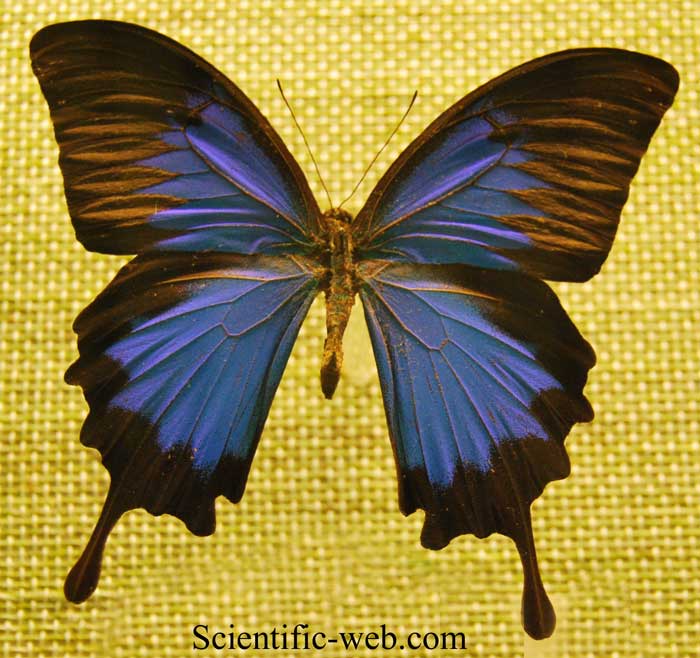
Papilio (Achillides) ulysses
Superregnum: Eukaryota
Cladus: Unikonta
Cladus: Opisthokonta
Cladus: Holozoa
Regnum: Animalia
Subregnum: Eumetazoa
Cladus: Bilateria
Cladus: Nephrozoa
Cladus: Protostomia
Cladus: Ecdysozoa
Cladus: Panarthropoda
Phylum: Arthropoda
Subphylum: Hexapoda
Classis: Insecta
Cladus: Dicondylia
Subclassis: Pterygota
Cladus: Metapterygota
Infraclassis: Neoptera
Cladus: Eumetabola
Cladus: Endopterygota
Superordo: Panorpida
Cladus: Amphiesmenoptera
Ordo: Lepidoptera
Subordo: Glossata
Cladus: Coelolepida
Cladus: Myoglossata
Cladus: Neolepidoptera
Infraordo: Heteroneura
Cladus: Eulepidoptera
Cladus: Ditrysia
Cladus: Apoditrysia
Cladus: Obtectomera
Superfamilia: Papilionoidea
Familia: Papilionidae
Subfamilia: Papilioninae
Tribus: Papilionini
Genus: Papilio
Subgenus: Papilio (Achillides)
Species: Papilio ulysses
Subspecies: P. (A.) u. ambiguus – P. (A.) u. ampelius – P. (A.) u. autolycus – P. (A.) u. denticulatus – P. (A.) u. dirce – P. (A.) u. dohertius – P. (A.) u. gabrielis – P. (A.) u. georgius – P. u. irisae – P. (A.) u. joesa – P. (A.) u. jennifeae – P. (A.) u. melanotica – P. (A.) u. morotaicus – P. (A.) u. nigerrimus – P. (A.) u. orsippus – P. (A.) u. oxyartes – P. (A.) u. penelope – P. (A.) u. scylla – P. (A.) u. telegonus – P. (A.) u. telemachus – P. (A.) u. ulysses
Name
Papilio ulysses Linnaeus, 1758.
Type locality: Asia.
Holotype: BMNH.
Synonymy
Papilio ulysses Linnaeus, 1758 Syst. Nat. (Edn 10) 1: 462. TL: Asia.
Papilio diomedes Linnaeus, 1758 Syst. Nat. (Edn 10) 1: 462. TL: India.
Papilio ulysses telephanes Fruhstorfer, 1902 Soc. Ent. 17 (8): 58; Dt. ent. Z. Iris 15 (1): 165. TL: Kiriwina, Fergusson.
Papilio ulysses agasophus Fruhstorfer, 1903 Dt. ent. Z. Iris 16 (1): 11. TL: Fergusson.
Papilio ulysses physkon Fruhstorfer, 1909 Ent. Zs. 22 (43): 177. TL: Waigeo.
Papilio ulysses eugenius Fruhstorfer, 1909 Ent. Zs. 22 (43): 177. TL: New Guinea.
Papilio ulysses eugenius f. principalis Fruhstorfer, 1909 Ent. Zs. 22 (43): 177. TL: New Guinea.
Papilio ulysses eugenius f. roxane Fruhstorfer, 1909 Ent. Zs. 22 (43): 177. TL: New Guinea.
Papilio ulysses taxiles Fruhstorfer, 1909 Ent. Zs. 22 (43): 177. TL: New Guinea, Milne Bay.
Papilio ulysses denticulatus Joicey & Talbot, 1916 Trans. Ent. Soc. Lond. 1916 (1): 68. TL: Bismarck Is.
References
Linnaeus, C. 1758. Systema Naturae per regna tria naturae, secundum classes, ordines, genera, species, cum characteribus, differentiis, synonymis, locis. Editio Decima, Reformata. Tomus I. Holmiæ (Stockholm): impensis direct. Laurentii Salvii. 824 pp. DOI: 10.5962/bhl.title.542 BHL p. 462 BHL Reference page.
Goode, Mark, 2012: A new subspecies of Papilio ulysses Linnaeus, 1758 (Lepidoptera: Papilionidae) from Gebe Island, North Maluku, Indonesia. Butterflies (Teinopalpus) 61: 10–12.
Dufek, V. ; O. Schäffler & M. Schmidbauer, : 2005: Beschreibung von 2 neuen Unterarten, sowie einer neuen Form von Achillides ulysses Linnaeus, 1758 (Lepidoptera: Papilionidae). Notes on Papilionidae, 3: 1–4.
Späth, M., 1992: Zwei neue taxa der gattung Papilio Linnaeus, 1758 aus Indonesien. (Lepidoptera: Papilionidae). Entomologische Zeitschrift 102 (16): 289–293.
Vernacular names
English: Mountain Swallowtail
русский: Парусник Улисс
Papilio ulysses, the Ulysses butterfly (also commonly known as the Blue emperor), is a large swallowtail butterfly of Australia, Indonesia, Papua New Guinea and the Solomon Islands. Its size varies depending on subspecies, but the wingspan is about 10.5 cm (4.1 in) in Queensland.[1]
This butterfly is used as an emblem for tourism in Queensland, Australia.
Description
Male of Papilio ulysses ambiguus from New Britain, Papua New Guinea
The Ulysses butterfly typically has a wingspan of about 14 cm (5.5 in), but depending on subspecies has some variations in size (western subspecies largest). The upperside of the wings are an iridescent electric blue; the underside is a more subdued black and brown. The colours are produced by the microscopic structure of the scales, a phenomenon called structural colouration.[2]
The female of the species is different from the male in that she has little crescents of blue in the back, upside sections of her hindwings, where there is only black for males. When the butterfly is perched the intense blue of its wings is hidden by the plainer brown under side of its wings, helping it to blend in with its surroundings. When in flight, the butterfly can be seen hundreds of metres away as sudden bright blue flashes. Males are strongly attracted to the colour blue, including blue objects which are sometimes mistaken for females.
Diet and conservation
Caterpillar
Conservation
The Ulysses butterfly inhabits tropical rainforest areas and suburban gardens. The Australian government requires breeders to obtain permits, although the species is not endangered. In the past, this butterfly had been threatened but planting pink flowered doughwood has increased its numbers. Reduction in the number of the Euodia trees, a tree heavily used for laying eggs and for leaves eaten by caterpillars, may threaten the survival of this butterfly. Females favour small trees up to 2 metres tall to lay their eggs.
Diet
The larval food plants of this butterfly include kerosene wood, a variety of Citrus, and Euodia. In Australia, the Ulysses butterfly imago is known to feed from the blossoms of the pink flowered doughwood, a tree with clusters of small pink flowers that extrude from its branches.[3]
References
Wildlife of Tropical North Queensland: Cooktown to MacKay. Queensland Museum. (2000), p. 114.
P. Vukusic, J. R. Sambles, C. R. Lawrence, R. J. Wootton (2001) Sculpted-multilayer optical effects in two species of Papilio butterfly. Applied Optics 40:1116-1125 "Archived copy" (PDF). Archived from the original (PDF) on 2007-02-22. Retrieved 2007-11-01.
"Facts About the Migration of the Ulysses Butterfly". PawNation. Archived from the original on 15 August 2013. Retrieved 1 November 2014.
Further reading
Erich Bauer and Thomas Frankenbach, 1998 Schmetterlinge der Erde, Butterflies of the World Part I (1), Papilionidae Papilionidae I: Papilio, Subgenus Achillides, Bhutanitis, Pooples. Edited by Erich Bauer and Thomas Frankenbach. Keltern: Goecke & Evers; Canterbury: Hillside Books, ISBN 9783931374624
Retrieved from "http://en.wikipedia.org/"
All text is available under the terms of the GNU Free Documentation License

